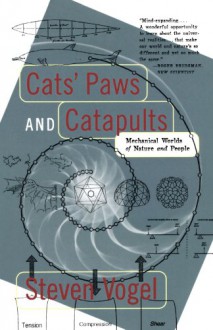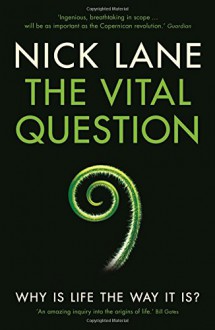

TITLE: Cats’ Paws and Catapults: Mechanical Worlds of Nature and People
AUTHOR: Steven Vogel
DATE PUBLISHED: 2000
FORMAT: Paperback
ISBN-13: 9780393319903
__________________________
DESCRIPTION:
"Nature and humans build their devices with the same earthly materials and use them in the same air and water, pulled by the same gravity. Why, then, do their designs diverge so sharply? Humans, for instance, love right angles, while nature's angles are rarely right and usually rounded. Our technology goes around on wheels—and on rotating pulleys, gears, shafts, and cams—yet in nature only the tiny propellers of bacteria spin as true wheels. Our hinges turn because hard parts slide around each other, whereas nature's hinges (a rabbit's ear, for example) more often swing by bending flexible materials. In this marvelously surprising, witty book, Steven Vogel compares these two mechanical worlds, introduces the reader to his field of biomechanics, and explains how the nexus of physical law, size, and convenience of construction determine the designs of both people and nature. "
__________________________
REVIEW:
This is an interesting and informative, scholarly, comparative overview of the difference between the way nature and humans engineer and manufacture things, the differences in the substances each uses to make those things, and the possibilities of why man and nature make things differently. Vogel has a clear, easy to understand writing style and provides many examples and diagrams to illustrate a point.
Other books:
~How to Walk on Water and Climb Up Walls: Animal Movement and the Robots of the Future by David L. Hu
~The Gecko’s Foot: How Scientists are Taking a Leaf from Nature's Book by Peter Forbes

TITLE: The Equations of Life: The Hidden Rules Shaping Evolution
AUTHOR: Charles S. Cockell
PUBLICATION DATE: 2019
FORMAT: Paperback
ISBN-13: 9781786493040
_____________________________
DESCRIPTION:
"A groundbreaking new view on the theory of evolution, arguing that life develops in predictable ways.
We are all familiar with the popular idea of strange alien life wildly different from life on earth inhabiting other planets. Maybe it's made of silicon! Maybe it has wheels! Or maybe it doesn't. In The Equations of Life, biologist Charles S. Cockell makes the forceful argument that the laws of physics narrowly constrain how life can evolve, making evolution's outcomes predictable. If we were to find on a distant planet something very much like a lady bug eating something like an aphid, we shouldn't be surprised. The forms of life are guided by a limited set of rules, and as a result, there is a narrow set of solutions to the challenges of existence.
A remarkable scientific contribution breathing new life into Darwin's theory of evolution, The Equations of Life makes a radical argument about what life can--and can't--be."
_____________________________
REVIEW:
In The Equations of Life, Cockell demonstrates that biology is dependent on, and thus constrained by, physics. The book starts off examining the social life of ants, moves on to studying how all the basic anatomy units and habits of a ladybug are constructed in accordance with the laws of physics, to the movement of moles through soil, birds through the air, and why animals don't have wheels or propellers. Cockell also examines why life is cellular, the various properties of cells and their particular building blocks (lipid membranes, DNA/RNA, amino acids, respiration, enzymatic reactions, the molecules and also atoms of life), why water is the solvent for life rather than something else (benzene? ammonia?), and if life can be based on something other than carbon. A few equations are thrown in to demonstrate a concept but there is nothing difficult to understand in this book. A fascinating perspective on evolution and physics written in an engaging manner.
PS: I love this cover. All those delicious equations, molecular structures and mathematical formulae etc.

TITLE: The Vital Question: Why Is Life the Way It Is?
AUTHOR: Nick Lane
DATE PUBLISHED: 2016
FORMAT: Paperback
ISBN-13: 9781781250372
_____________________________________
BLURB:
“There’s a black hole at the heart of biology: we do not know why life is the way it is. Bacteria evolved into complex life just once in four billion years of life on earth, and all complex life shares many strange properties, from sex to ageing and death – but why?
In The Vital Question, award-winning author and biochemist Nick Lane radically reframes evolutionary history, putting forward a cogent solution to conundrums that have troubled scientists for decades. The answer, he argues, lies in energy: how all life on Earth lives off a voltage with the strength of a lightning bolt. In unravelling these scientific enigmas and making sense of life’s quirks, Lane’s explanation provides a solution to life’s vital question: why are we as we are, indeed, why are we here at all?”
______________________________________
REVIEW:
This is a nicely written science book for intelligent people. No interviews or fashion commentary. Lane examines the fundamental requirement of life, namely energy. The starts off with examining what life and living is and then takes a look at how (and where) the first cells possibly evolved. Many hypotheses are examined, discarded or elaborated upon. Lane also takes cell evolution further by examining the evolution of complex cells, why most eukaryotes have two different sexes, how cells die, what powers a cell, and a host of other interesting goodies. There is a fair amount of physics, biochemistry and chemistry in this book, along with several illustrations and diagrams. Lane tends to be a bit repetitive, but with a complex subject like this, it probably helps to recap previous points. This is a fascinating book that makes a great addition to his previous book Power, Sex, Suicide: Mitochondria and the Meaning of Life.

TITLE: Zombie Science: More Icons of Evolution
AUTHOR: Jonathan Wells
DATE PUBLISHED: 2019
FORMAT: ebook
ASIN: B06Y398ML7
________________________
DESCRIPTION:
In 2000, biologist Jonathan Wells took the science world by storm with Icons of Evolution, a book showing how biology textbooks routinely promote Darwinism using bogus evidence—icons of evolution like Ernst Haeckel’s faked embryo drawings and peppered moths glued to tree trunks. Critics of the book complained that Wells had merely gathered up a handful of innocent textbook errors and blown them out of proportion. Now, in Zombie Science, Wells asks a simple question: If the icons of evolution were just innocent textbook errors, why do so many of them still persist? Science has enriched our lives and led to countless discoveries. But now, Wells argues, it’s being corrupted. Empirical science is devolving into zombie science, shuffling along unfazed by opposing evidence. Discredited icons of evolution rise from the dead while more icons—equally bogus—join their ranks. Like a B horror movie, they just keep coming! Zombies are make believe, but zombie science is real—and it threatens not just science, but our whole culture. Is there a solution? Wells is sure of it, and points the way.
_______________________________
COMMENT:
Interesting. Provides food for thought and more stuff to research.